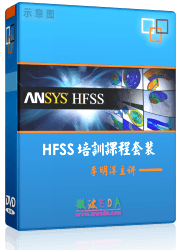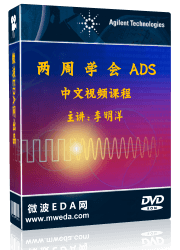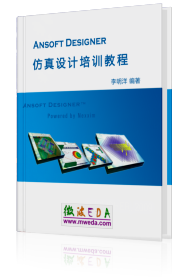Vent
Shapes Faces and Apertures Faces and Apertures Vent Vent
Vents are used to model perforated metal screens, which are commonly
used as windows or ventilation panels on metal enclosures. For frequencies
at which the width of the individual apertures is significantly smaller
than half a wavelength, these screens are only weakly penetrable to electromagnetic
fields.
Precise modelling of individual apertures in a vent would require a
cell size of just a fraction of the aperture width. This is often impractical
for air vents, as the apertures may be fairly small. An alternative approach
is to replace the screen with a panel of homogeneous material having the
same large-scale electrical properties. Any effects due to individual
apertures are then lost, but the cell size of the model may be chosen
without any reference to the aperture size.
A Vent may be specified over all or part of a thin metal panel. The
Solver estimates the electrical properties of the vent from the size and
shape of its apertures and from the thickness and fractional open area
of the screen. That part of the metal panel covered by the vent is then
replaced by a panel of a special material having the appropriate properties.
Note that the original metal panel should have no thickness. The thickness
of the screen is regarded as an electrical rather than a geometric property,
and is not determined by the thickness of the underlying metal.
Grating Effects
At frequencies for which the aperture-spacing (pitch) of a perforated
screen is greater than half a wavelength, the screen can function as a
diffraction grating. That is, the screen can produce diffracted and reflected
waves at angles which differ from the angle of incidence of illumination
(the limit is a half rather than a full wavelength to allow for grazing
incidence). Since the vent model is homogeneous it cannot produce this
effect, and so should only be used when the pitch of the screen is less
than half a wavelength (at the highest frequency of interest).
Even when its pitch is less than half a wavelength, a real screen will
give rise to local evanescent fields in addition to the ordinary transmitted
and reflected rays. For the worst case of grazing incidence, the least
evanescent space-harmonic produced by a screen of pitch p, will decay
by a factor of e, in going through a distance away from the screen of
At distances much larger than this, the evanescent fields will be negligible
in comparison to the ordinary transmitted and reflected rays. Conversely,
if an object is placed within a distance of the
screen, then coupling to the evanescent field could make a significant
contribution to transmission through the screen. This imposes a further
limitation on the use of the vent model; namely that there should be a
clear space of (say) 2 on either side of the screen.
Note that if the wavelength is much greater than twice the pitch then
~ pitch/(2pi).
Isotropy
A round or square aperture has electrical properties which are (to a
first-order approximation), isotropic in the plane of the screen. This
is also true for any aperture which has rotational symmetry for any angle
of less than 180掳 - a hexagonal aperture for example. A screen with apertures
of this type will itself be isotropic. If the pattern of apertures is
anisotropic - if the apertures are closely spaced in one direction and
widely spaced in the perpendicular direction, then the screen may still
be taken as isotropic provided that the wider spacing is less than half
a wavelength.
An elongated aperture has anisotropic electrical properties. A screen
with elongated apertures will itself be anisotropic if the apertures are
all parallel to one another. The vent model is not capable of modelling
such anisotropic screens.
If the individual apertures are anisotropic, but are at different orientations
to one another, then the screen as a whole may be isotropic. The precise
requirement is that the angular distribution of aperture axes has rotational
symmetry for any angle of less than 180掳. A screen having elongated apertures,
with each aperture at 90掳 to its neighbors would meet this requirement.
In this case, the screen should be treated as though half the apertures
(the effective fraction parallel to any given polarization), were absent.
Summary of Limitations
In summary,
the vent model should only be used if the following conditions are met:
The aperture spacing (pitch
of the screen) is less than half a wavelength at the highest frequency
of interest. The screen is isotropic (does
not consist of parallel elongated apertures). The aperture depth (screen
thickness) is no greater than the aperture width. No objects
are so close to the screen as to disturb the fields in the vicinity of
individual apertures. If the pitch of the screen is much less than half
a wavelength, then that is (say), closer than one third of the pitch.
Vent Dialog
Name:
Specify a unique name for the vent.
Shape:
Here you select the shape of the vent aperture. Round, square or hexagonal,
or whichever of these best approximates the actual aperture shape.
Owner type:
The vent can be specified over all or part of a metal panel. If you pick
a face that is aligned to one of the coordinate axes before opening the
Vent dialog, picked face will define the dimensions of the vent region.
If you pick two points on one face and if
this face is aligned to one of the coordinate axes, then these two points
will define the opposite corners of the vent region.
If there are no suitable picked points or
face when the Vent dialog is opened, then the vent will be specified over
the whole surface of the selected metal panel.
Axial
face: Depending on pick, the entire face or a portion of the face
will be used as the vent region. Sheet
body: The whole surface of the body will be used as the vent region.
Vent parameters frame
Width /
Radius / Side length: Depending on shape selected, specify here
the width or radius or side length of the vent apertures.
Depth:
Specify the thickness of the screen.
Coverage:
Specify the vent coverage in the selected region. This is a number between
0 and 1, being the fraction of the area of the screen which is occupied
by apertures. It is the percentage open area expressed as a decimal fraction.
The Solver does not take any account of the pattern in which the apertures
are arranged - whether on rectangular grid, or in staggered rows.
Vent region frame
Xmin
/ Xmax / Ymin / Ymax
/ Zmin / Zmax: The bounding
box of the vent region.
Picks: Before entering this dialog, if points are picked,
this option will be enabled.
OK
Press
this button to create the vent.
Preview
Press this button to
create a preview image of the vent. This option is very useful to check
the settings before you actually create the vent.
Cancel
Closes this dialog box without performing any
further action.
Help
Shows this help text.




HFSS视频教程
ADS视频教程
CST视频教程
Ansoft Designer 中文教程
|